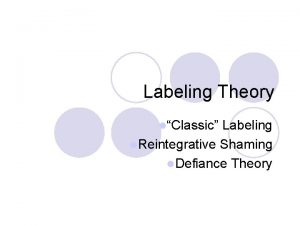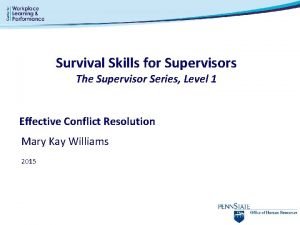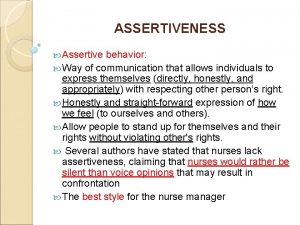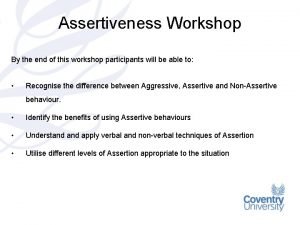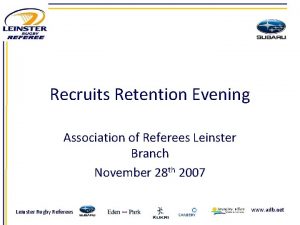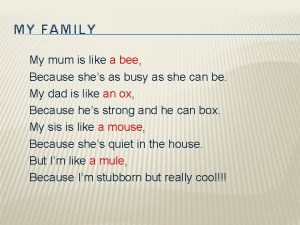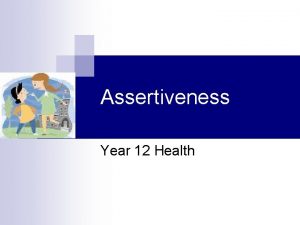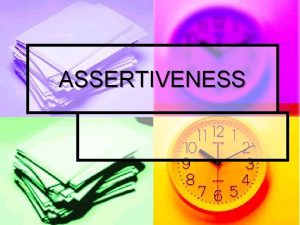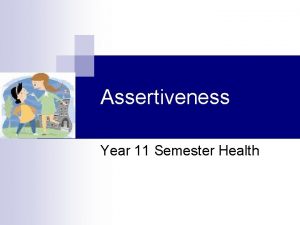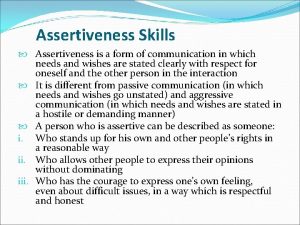Assertiveness and dealing with mum shaming This presentation


























- Slides: 26

Assertiveness and dealing with mum shaming This presentation looks at how assertiveness skills and understanding mum shaming can help us out of the cycle of poor self esteem, unhelpful thinking, low mood and/or depression.

Poor self worth or low confidence in parenting choices Self criticism (unhelpful thinking) and/or resentment towards others Passive or aggressive (not assertive) Unclear boundaries and values Mum Shaming

Assertiveness Communication Styles Passive – Usually violates our own rights and puts the needs of others first. Not expressing thoughts and feelings honestly. Aggressive - Usually violates the rights of others and puts own needs first. Expressing thoughts and feelings in an inappropriate way. Assertive – Respects own needs and the needs of others while being open and honest about our thoughts and feelings

Passive Communication Hesitant, filled with pauses Soft or unclear speech Frequent throat clearing Justifications, e. g. , “I wouldn’t normally say anything” Apologies, e. g. , “I’m terribly sorry to bother you. . ” Qualifiers, e. g. , “I might be wrong” Self-dismissal, e. g. , “It doesn’t really matter” Looking down Posture can be slouched Covering mouth with hand Jaw trembling Beat-around-thebush

Aggressive Communication Often fast speech Emphasising blaming words Firm voice Tone sarcastic, cold, harsh Often shouting, rising at end Use of threats, e. g. , “If you don’t. . . ” Put downs, e. g. , “You’ve got to be kidding. . . ” Threatening questions, e. g. , “Haven’t you finished that yet? ” Intruding into the other person’s space Staring at the person Pointing, fist clenching Leaning forward or over Crossing arms Jaws set firm

The Assertiveness Pendulum The assertiveness pendulum happens when a person is too passive and consequently finds that their needs are not being meet, their voice not being heard, perhaps being ‘walked all over’, becomes so frustrated and distressed by others lack of care and concern that it leads to a sudden swing and outburst of aggressive communication. It can happen in the opposite direction, where a person who tends to use aggressive communication attempts to curb their behaviour but instead becomes too passive. The pendulum can swing back and forth, in attempts to have our needs met but never actually being assertive.

Assertive Language Assertive non-verbal language might include: Assertive language might include: Eye contact (not staring) Steady even pace and tone Open, relaxed posture Firm but relaxed voice Smiling when pleased or frowning when angry Clear and direct Actively listening Use of ‘I’ statements Open hands Use of empathic statements Relaxed jaw Discrepancy statements Repetition (broken record technique)

I statements – “When you. . . I feel. . . I’d like. . . ” • “John, when I am speaking, and you interrupt me, I feel frustrated annoyed. I’d like it if you wait until I finish. ” Broken record – Repeating yourself over and over. Assertive statements • ‘Sue, can I borrow $20? ” • “I can’t lend you any money right now” • “I will pay you right back” • “I can’t lend you any money right now” Empathy statement – “I can see. . . but I need. . . ” • “I know you are busy right now John, but I need you to help do this” Discrepancy statement – “It seems that on the one hand. . . while on the other hand. . . ” • “It seems that on the one hand you say you will repair this, while on the other • hand you told me it is too difficult to fix”

Saying “NO” Many people have great difficulty saying “No” to others. Even people who are quite assertive in other situations may find themselves saying “Yes” to things that they really don’t want to do. If you say “Yes” when you really mean “No”, resentment and anger can build up towards the person you have said “Yes” to, even though they have done nothing wrong. In the long term not being assertive in this way can decrease your self esteem and lead to depression and anxiety.

Unhelpful beliefs about saying no Saying “no” is rude Saying “no” is unkind, uncaring and selfish. Saying “no” will hurt and upset others and make them feel rejected. If I say “no” to somebody they won’t like me anymore. Other’s needs are more important than mine. I should always try and please others and be helpful. Saying “no” over little things is small minded and petty.

Helpful beliefs about saying “no” Ideas? ? It is okay to say no I know my values and I am sticking to them If I agree to this I am devaluing myself

Saying “no” Be straightforward and honest so that you can make the point effectively Keep it brief Tell the person if you are finding it difficult Be polite – say something like “thank you for asking. . . ” Speak slowly with warmth otherwise “no” may sound abrupt. Don’t apologise and give elaborate reasons for saying “no”. It is your right to say no if you don’t want to do things. Remember that it is better in the long run to be truthful than breed resentment and bitterness within yourself When saying “no” take responsibility for it. Don’t blame or make excuses. Change “I can’t” to “I don’t want to”.

Ways of saying “no” The reflecting ‘no” This technique involves acknowledging the content and feeling of the request, then adding your assertive refusal at the end. For example “I know you are concerned about Johnny, but this is what I/we have decided to do”. Or “I know you’re looking forward to a walk this afternoon but I can’t come”

Ways of saying “no” The reasoned “no” In this technique you give a very brief and genuine reason for why you are saying “No”. For example “I can't have lunch with you because it is during Johnny’s nap time”.

Ways of saying “no” The enquiring “no” This is not a definite “no”. It is a way of opening up the request to see if there is another way it could be met. For example “Is there any other time you’d like to go? ” “Are there any other suggestions you have? ”.

Where do I start? Identify your boundaries and know your red flags What are my values? What am I willing to tolerate and what is not okay for me? It is difficult to be assertive if you don’t know what your values and boundaries are and/or if you don’t value yourself

Be aware of your boundaries Practice saying ‘no’ Being Assertive Ask for more time Be aware of your speech and body language Practice using assertive statements

Shame and Guilt Shame is a response to social threat – it is activated by the threat system. It is involved in protecting us from the threat of rejection. This can lead us to withdraw, feel rejected and even defective. Physically, shame can lead us to lose energy and almost collapse into ourselves. Ever had that feeling you just want to put your head down and disappear? Guilt is a feeling that arises from a feeling of wronging doing to another – it is activated by the soothing/affiliative system. With guilt, our urge is to repair, say sorry or make it better somehow.

Shame and Guilt So, shame makes us hide away what we feel we are doing wrong whereas guilt helps us to reach out, and repair. If we can shift shame to guilt then we are more able to reconnect, seek resolution to the problem By bringing awareness to feelings of shame, we can label it and work on shifting it to guilt. Using self-compassion, we can offer ourselves kindness and warmth, which leads to a reduction of shameful emotions. This can enable us to better connect and reach out.

Mum Shaming A recent national US poll (2017) that surveyed mothers of children 0 -5 years old found that the majority of mothers had experienced Mum shaming of some nature. 46% had experienced this about sleep issues and 39% about breast versus bottle feeding. Sixty two percent reported receiving unhelpful advice from others. The most common group of offenders were family members beginning with the mother’s family, the child’s other parent and closely followed by the in-laws. Friends, other mothers in public and social media were also offenders, to a lesser degree. For 42% the Mum shame led them to feel unsure about their parenting choices. (data from Mott Poll Report, 2017)




Dealing with Mum Shaming As you are now aware, most mothers unfortunately experience some sort of criticism as part of being a parent. So, we can start by firstly accepting this fact and expect to be challenged so you won’t be surprised or caught off guard when it happens. Mum shaming is often about someone’s own insecurities or guilt about things they wish they had done differently and even look at it as an opportunity to redo these things. Surround yourself with people you trust and feel secure with. Reduce the time you spend with those who judge you, even if they are family or friends. Accept that some days you will feel as if you are not doing a good job or didn’t make the best choice. No one is perfect; all parents make mistakes (perceived or real) now and again. We are all imperfect.

Dealing with Mum Shaming Don’t be influenced by friends whose parenting looks seamless and easy—what you see especially online is often a smokescreen. What you take as judgment may be ignorance. People around you may not know your history or why, for instance, you don’t breastfeed or not want to use childcare. You know your child better than anyone else. Spend time thinking about your parenting values and practice being confident about what you believe is best for your child and you, not what others believe. Challenge your thinking and use your assertiveness skills where needed Apply self-compassion when your buttons are pushed

Thank you!
 Sherman defiance theory
Sherman defiance theory Stigmatic shaming
Stigmatic shaming Low assertiveness and high cooperativeness
Low assertiveness and high cooperativeness Body language
Body language Wilson learning social styles test
Wilson learning social styles test Fuck you and your mum
Fuck you and your mum Graded assertiveness
Graded assertiveness Assertiveness discussion questions
Assertiveness discussion questions Barriers to assertiveness
Barriers to assertiveness What is an assertive tone
What is an assertive tone Barriers to assertiveness
Barriers to assertiveness Pace graded assertiveness
Pace graded assertiveness Assertiveness workshop
Assertiveness workshop Assertiveness quiz
Assertiveness quiz Jerome counihan
Jerome counihan Assertiveness bill of rights
Assertiveness bill of rights Mum father
Mum father Biff and chip mum
Biff and chip mum Chapter 5 lesson 1 dealing with anxiety and depression
Chapter 5 lesson 1 dealing with anxiety and depression Chapter 5 lesson 1 dealing with anxiety and depression
Chapter 5 lesson 1 dealing with anxiety and depression If only tense
If only tense Total protez mum duvar yapımı
Total protez mum duvar yapımı My family my mum is like a bee
My family my mum is like a bee My mother is as busy as a bee
My mother is as busy as a bee Acha mum
Acha mum Describe about your mother
Describe about your mother Inley mum
Inley mum
